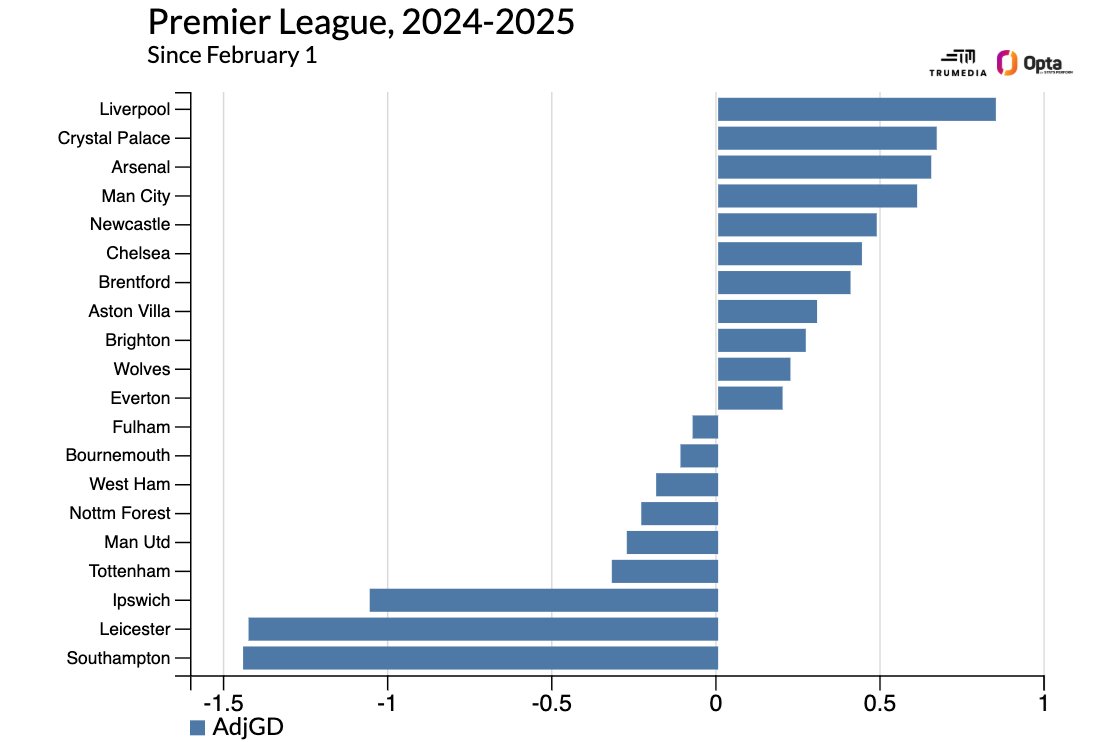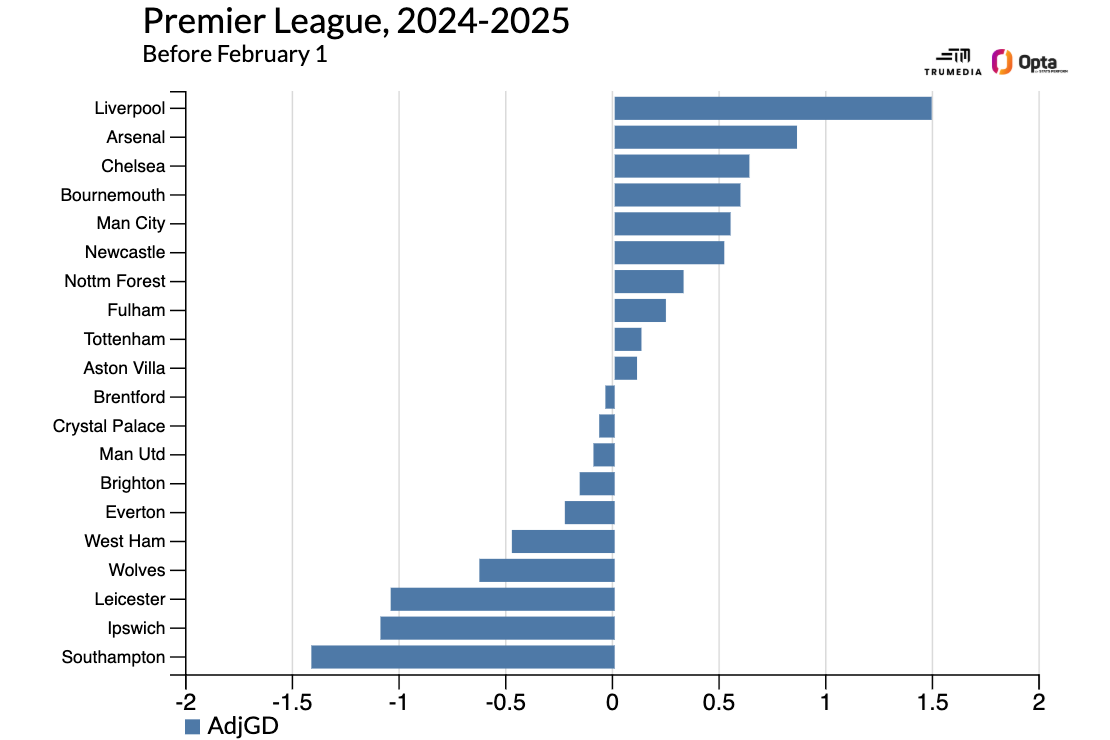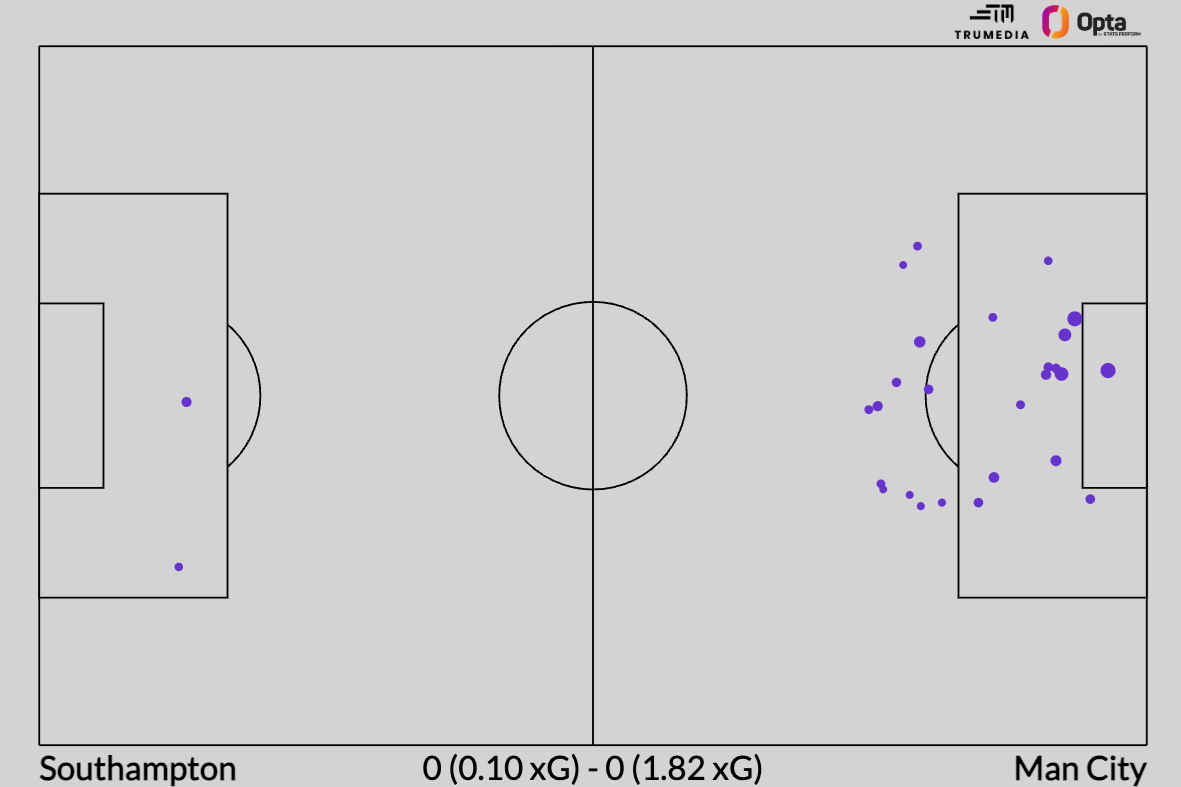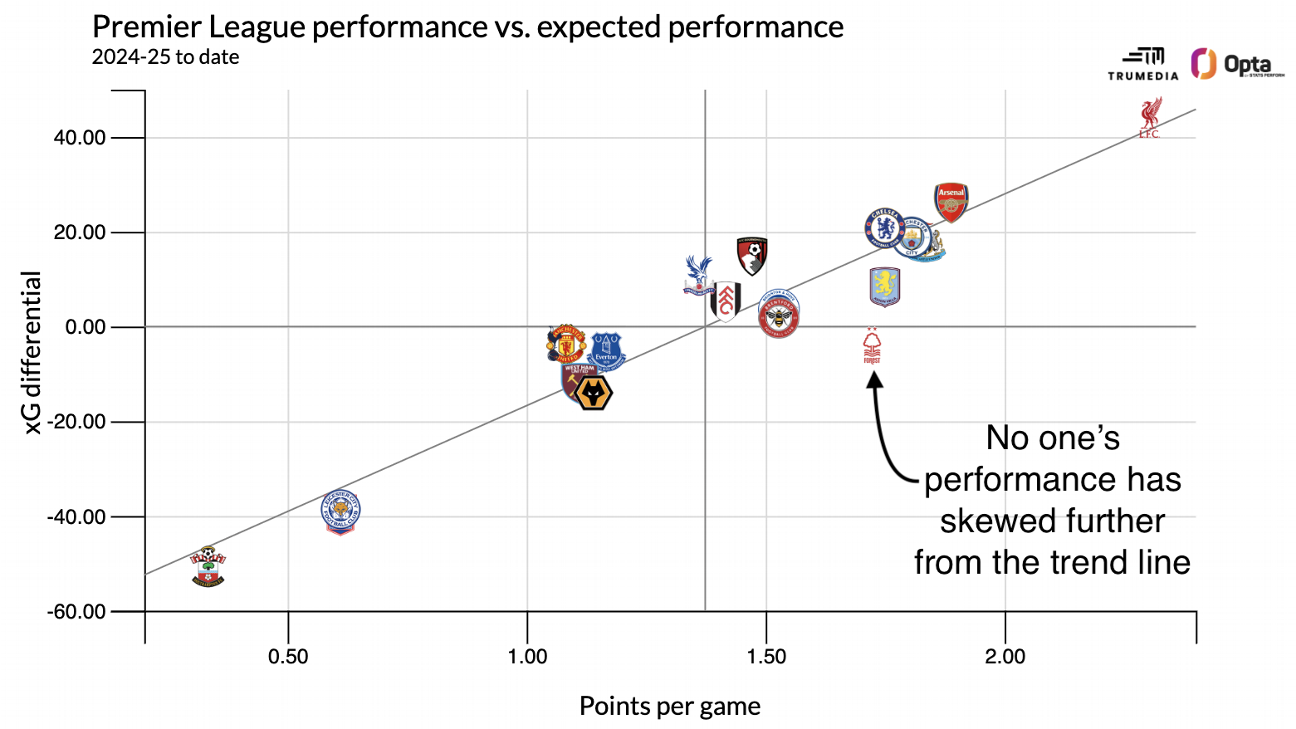Bill Connelly

Bill Connelly
ESPN Staff Writer
- Bill Connelly is a writer for ESPN. He covers college football, soccer and tennis. He has been at ESPN since 2019.
Ryan O'Hanlon

Ryan O'Hanlon
ESPN.com writer
- Ryan O'Hanlon is a staff writer for ESPN.com. He's also the author of "Net Gains: Inside the Beautiful Game's Analytics Revolution."
May 16, 2025, 06:00 AM ET
In August, it felt optimistic to rank Nottingham Forest even 14th in the Premier League. In September, we thought that either Brighton or Tottenham Hotspur were among the five best teams in England. In November, we still thought Spurs were top-five contenders and, even more damning, we thought Manchester United were worthy of a midtable spot. (Silly us.) In January, we were all aboard the AFC Bournemouth train.
Record semi-regular power rankings for long enough and you begin to realize just how frequently one's perceptions can change over a ridiculously long season. And in a year in which both the title and relegation fights were over before May, we reach the final stretch of the 2024-25 Premier League campaign watching Newcastle United and Aston Villa rise and Forest fall back toward where they began the season. (We're also dreaming of a postseason playoff.)
Below are our final updated power rankings for the 2024-25 season, followed by some analysis of the most notable changes from our previous rankings in January. Newcastle and Villa are flying high, Manchester City have been laminated on that No. 4 spot for a while, everyone has been great and terrible at some point, and Forest have stumbled in an extremely predictable way.
The updated Premier League team rankings
We last did this in January, and our re-rankings -- the combination of the individual rankings from Bill Connelly and Ryan O'Hanlon -- are listed along with the new May adjustments, plus each team's present points total in the Premier League table and goal differential. Here's our final re-rank of the 2024-25 Premier League season:
Better late than never from Newcastle and Aston Villa
Imagine that the Premier League had a season-ending playoff system like they do in the Belgian Pro League; after the regular-season round-robin is complete, everyone's point totals are cut in half and the top six teams play an additional round-robin to determine the league's champion. Granted, this doesn't really work for a 20-team league (Belgium's has 16) -- that's a 38-game regular season, followed by 10 more games -- but we can do whatever we want in a thought experiment.
Using analyst Simon Tinsley's full-season projections and rounding odd numbers up, we would start a six-team Premier League playoff with Liverpool at 44 points, Arsenal at 37, Manchester City and Newcastle at 35, and Chelsea and Aston Villa at 33. It would still take a monstrous comeback for someone to catch Liverpool, but based on current form it wouldn't be unrealistic to think that Newcastle and Aston Villa might round out a post-playoff top three.
Newcastle have lost just one of their last 10 matches in all competitions -- and that one loss was to Villa, who have lost just three of their last 15. Since March 8, these are the only two teams to average more than 2.0 points per game in league play (Villa at 2.63; Newcastle 2.44), and they aren't really overachieving any of their underlying numbers. They've simply been two of, at worst, the top three teams in the league.

In this span, Newcastle are first in goals scored and third in goals allowed; Villa are the opposite: third in goals, first in goals allowed. They have moved up accordingly in our power rankings.
Newcastle are getting sustained brilliance from the wing pairing of Jacob Murphy (right) and Harvey Barnes (left); since March 8, they have combined for seven goals and seven assists.
Barnes has supplanted Anthony Gordon on the left side of the attack and, with 13 combined goals and assists this season, he's close to matching the 14 he produced in 1,100 more minutes at Leicester City in 2022-23. He's also completed 74 progressive carries in this span, second on the team and fifth in the league among non-defenders. Combined with Alexander Isak's continued brilliance, Barnes has given Newcastle's ultra-direct attack a jolt of life just as others' energy levels in the league have dissipated.
For Villa, meanwhile, it's been all about the combination of increasingly sturdy defense and attacking reinforcements from the bench. Their possession rate during this brilliant run is just 41.4% (16th in the league), and they're averaging just 29.3 touches in the attacking third (18th). But while they're allowing opponents to take as many shots as they want -- since March 8 they're allowing 0.16 shots per possession (17th) -- none are from good positions. They're allowing just 0.11 expected goals (xG) per shot, the lowest in the league.
Once they've properly absorbed pressure, Villa counter attack pretty well, especially late in a match. From the 70th minute onward, they've scored seven goals in this span (most in the league) and allowed just one (fewest). Adding both Marcus Rashford (loan) and Donyell Malen (€23 million) in the January transfer window allowed Emery to shuffle his attackers and create valuable substitutions, and Malen has two of those seven late goals.
Both teams needed this late surge. Heading into March 8, Villa were seventh in the league with 45 points and Newcastle were eighth at 44. Newcastle had lost four of six league matches, dropping decisions to Liverpool and Manchester City by a combined 6-0, while Villa had endured a five-match league winless streak. Now they're both among the top 10 teams in the world, per the Opta supercomputer.
Newcastle's odds of finishing in the top five have surged to 95%, per both Opta and Tinsley; Villa's are between 37% (Tinsley) and 42% (Opta). And those odds don't factor in that their final two matches are against Europa League finalists Tottenham Hotspur (May 16) and Manchester United (May 25) on both sides of that final. They could benefit from distraction in both instances. -- Connelly
Manchester City never really found fifth gear
I think we all expected Manchester City to figure it out at some point, right? To start scoring goals for fun? To shut things down at the other end? To control, suffocate and dominate games like they've been doing for nearly a decade?
Instead, there are two games left in the season, and City are just two points (and some goal differential) clear of missing out on the Champions League altogether. Now, they're probably not going to miss out -- Tinsley's projections give City a 95% likelihood of finishing in the top five -- but there's still a chance they don't.
Per Transfermarkt, City spent €218m on transfer fees for five players in January, while no other club in Europe was north of €55m. With all those new players in tow, here's how they've performed since the start of February -- based on their adjusted goal difference (a blend of 70% xG and 30% goals):

And here's how things looked before the start of February:

The numbers improved slightly: up from plus-0.54 to plus-0.61, and up from fifth-best to fourth-best. But this wasn't City returning to form as a Premier League- and Champions League-level challenger, like we saw with Liverpool toward the end of both of their down years, 2020-21 and 2022-23, under Jurgen Klopp. This was a borderline top-four-level team turning into a slightly less borderline top-four-level team.
Now, the defense has improved drastically. Their adjusted goals-allowed number was 1.41 per game before February, and it's plummeted all the way down to 0.96 since then. City are allowing nearly five fewer shots per game -- 13.3 before February; 8.0 since -- and they've allowed significantly tougher shots, too: 0.11 xG per shot, compared to 0.14 before February. The press, too, has been a little more aggressive and a little more effective now that they've integrated some younger legs into the lineup.
But it's come at a significant cost at the other end. City's adjusted-goals number has slipped from 1.96 per game before February to 1.57 per game since. Before February, they were attempting 17.2 shots per game -- just slightly behind Liverpool's league-leading mark of 17.7. But since February, that number has dropped to 13.8, and the quality of the shots hasn't improved at all.
So, basically, they're trading one form of instability for another. Before the January window, City could attack but they couldn't defend. And now they can defend but can't attack. Just take last weekend's Southampton game: They faced a team with nothing to play for -- and one that, according to City defender Rúben Dias, "didn't even try" -- but they were totally unable to generate any quality attempts.

What all this means is that City are not guarantee to win either of their remaining games, especially against tricky midtable teams like Fulham and Bournemouth. This just still isn't a team that can tilt the field so much that their opponent falls off the other end.
They'll probably hang on to finish in the top five, since they have a points lead and a goal difference lead, but if the team are going to bounce back to Premier League title contention next season, a lot is going to have to change. Right now, they're not even close to Liverpool ... or even Arsenal. -- O'Hanlon
Nottingham Forest couldn't outrun xG forever
On April 1, barely six weeks ago, Nottingham Forest beat Manchester United 1-0. Including a 0-0 draw with Arsenal and a 1-0 win over Manchester City, it extended a key unbeaten streak to four games. With eight matches to go, Forest were in third place with 57 points, eight ahead of fourth-place Chelsea, nine ahead of fifth-place City and, most importantly for Champions League qualification, 10 points ahead of sixth-place Newcastle.
Six matchdays later, they're in seventh. After blowing two different leads in a 2-2 draw against relegated Leicester City on Sunday, they're now a point behind in the race for a top-five spot and, with the way they've been playing, that gap feels much larger. They've won just one of their last seven games in all competitions and only one of six in the Premier League. If ever there were a use for the word "collapse," it's apt here.
It's only sort of a collapse, though. Looking at the advanced stats, it was pretty clear that Forest were running extraordinarily hot. It was only a question of whether they could lock down a Champions League berth before they came back down to earth. That is now looking unlikely.
On April 1, Forest had scored 50 goals (sixth in the league) on shots worth just 38.0 xG (15th). Their goal differential was plus-15 (fourth), despite an xG differential of plus-1.8 (10th). They had won five league matches with a negative xG differential, and in nine matches with an xG differential of minus-0.75 or worse, they had managed to steal eight points with two wins and two draws.
Meanwhile, in nine matches with a plus-0.75 xG differential or better, they had taken nine wins. They had certainly produced some sterling performances, and players like Murillo and Chris Wood -- the chief xG overachiever (he's scored 20 league goals from shots worth 12.4 xG) -- have been among the league's best. After finishing 16th and 17th over the previous two seasons, even improvement to about 10th would have been noteworthy. But, well, they had as many minus-0.75 performances as plus-0.75s above; that isn't a Champions League-worthy statistical résumé.

On paper, Forest should be closer to Everton and Manchester United than Chelsea and Manchester City and, unfortunately for them, reality is finally beginning to reflect that. Forest's form has certainly taken a further downturn in this awful six-match swing -- they've actually still managed to overachieve against xG, stealing a 2-1 win over Spurs (xG differential: minus-1.7) and a 1-1 draw with Palace (minus-1.6) in this span. But since April 2, they rank 15th in points per game (0.83) and 17th in xG differential (minus-5.6). They've hit a brick wall, but it's only so much of a surprise.
Of course, the story is not over just yet. This weekend, Forest play West Ham -- a team in form as rickety as theirs -- before hosting Chelsea in their final game. That might be a Champions League play-in of sorts, and Chelsea won't have suspended forward Nicolas Jackson, whose absence is usually noteworthy. (Chelsea average 1.89 points per game when Jackson starts and 1.50 when he doesn't.)
It would only take a couple more breaks for Forest to make their long-awaited return to the Champions League, a competition they won in 1979 and 1980 (when it was called the European Cup), but it might turn out that they've already exhausted their supply of good breaks. -- Connelly
Everyone in the middle's been great and terrible at some point
Don't look now, but Brentford are all the way up to eighth place. And while the table doesn't show it, this weekend's FA Cup finalists, Crystal Palace, might be even better than that, as they're currently eighth in the season-long adjusted-goal-difference table. More importantly, these two clubs are the biggest risers in the latest edition of these re-rankings.
We've been enamored with various other mid-ish table clubs throughout the season, too. There was a period where Brighton's talented young players and manager were putting up impressive results, week in and week out. We've been high on Fulham. We've liked what Everton have done since David Moyes returned. We like what Wolves are doing right now. We rode the Forest train until it ran out of steam. And we once even tabbed Bournemouth as one of the favorites for a Champions League place.
The point is: the Premier League's midtable is stacked and that's been lost amidst the awful relegated sides, Liverpool's walk to the title, and the struggles of almost every other big club. But I think part of the reason that most of the big clubs have struggled this year is that there are fewer "gimme" matches than ever before. Throw Villa into the mix above and you have nine teams outside of the traditional Big Six and Newcastle who have been genuinely tough to play against this season, at least at some point.
This isn't just a subjective feeling, either.
The Club Elo ratings view clubs purely based on their results. There are no league adjustments or underlying data sources or anything like this. You win games, you gain rating points. You lose a game, you lose points. And how many points you win or lose is determined by the quality of the opponent (based on all the points they've won and lost in the past) and the location of the game.
Based on these rankings, Villa are the 11th-strongest team in the world; Palace sit 16th and Brentford 17th, sandwiched below Napoli and above Borussia Dortmund. Then there's Bournemouth in 20th, one spot below Roma and one ahead of Juventus. Forest are 22nd, below Juve and ahead of AC Milan. And Brighton are one spot below Milan. Thanks to their Europa League performance, even Manchester United sneak into the last spot of the top 25.
Put another way, the teams sitting in sixth, seventh, eighth, ninth, 10th, 12th, and 16th in the Premier League are all among the 25 best teams in the world.
Stretch it out to the top 50 and Tottenham (31), Everton (33), Fulham (34), West Ham (41), Wolves (44) all make it, as do the two automatic qualifiers from the Championship: Burnley (47) and Leeds (49). Were team strengths distributed equally across the five biggest countries, you'd expect each league to have eight or nine teams -- leaving some room for the best teams in the Netherlands and Portugal.
Instead, the Premier League has 17 teams in the top 50 and that number will shoot up to 19 next season. Although the top seems weaker -- and I'm not sure it actually is, as Liverpool and Arsenal rank No. 1 and No. 2 in Club Elo -- the league as a whole is stronger than ever before. And it's only going to get harder next season. -- O'Hanlon
.png)
 German (DE)
German (DE)  English (US)
English (US)  Spanish (ES)
Spanish (ES)  French (FR)
French (FR)  Hindi (IN)
Hindi (IN)  Italian (IT)
Italian (IT)  Russian (RU)
Russian (RU)  12 hours ago
1
12 hours ago
1









Comments